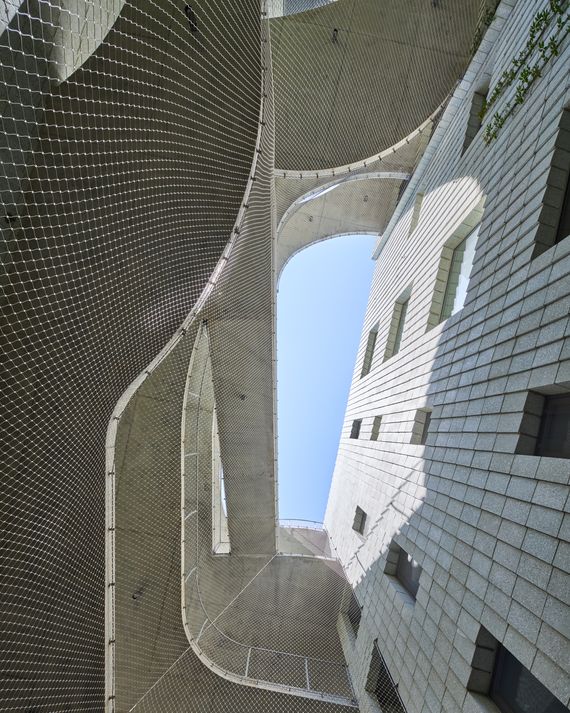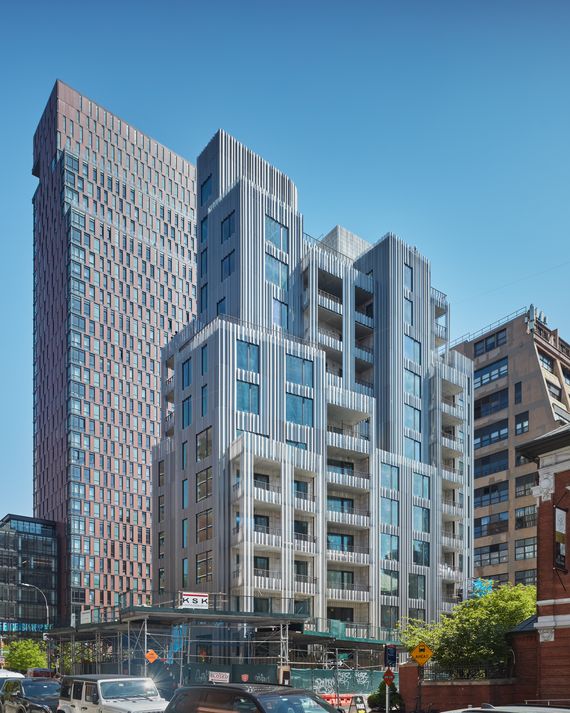There’s a jaunty pink palazzo going up on a corner in Fort Greene, a jumble of bays, balconies, stacked rooms, and mini-towers that, especially in its unfinished state, looks more like a midnight sketch than an actual hunk of New York real estate. Move closer, and the delirium resolves into rational construction. The loud paint job subsides into fluted concrete panels tinted — not painted — a vibrant dusty rose. A set of rowhouses along Vanderbilt Avenue clambers up to an eight-story apartment complex at the intersection with Myrtle Avenue. A two-story bay juts out beneath a terrace, and as that play of protrusion and retreat comes into focus, so does the history it invokes. The building at 144 Vanderbilt Avenue, the third in a series of Brooklyn projects planned by the tiny company Tankhouse and designed by SO-IL, intimates how varied New York residential architecture could be again, if only more developers and architects dared to shake off their lazy provincialism.
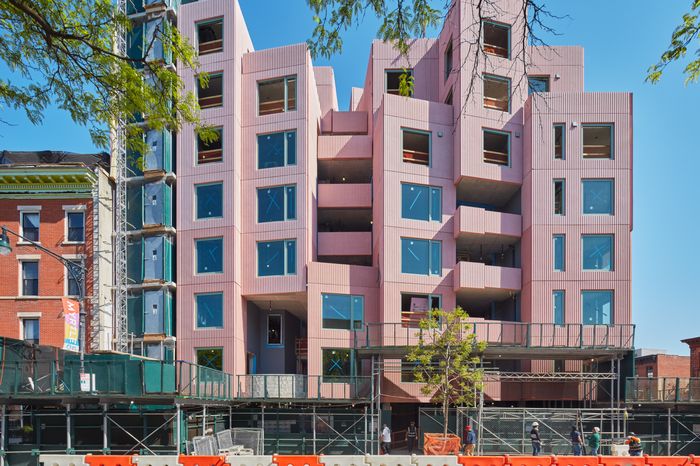
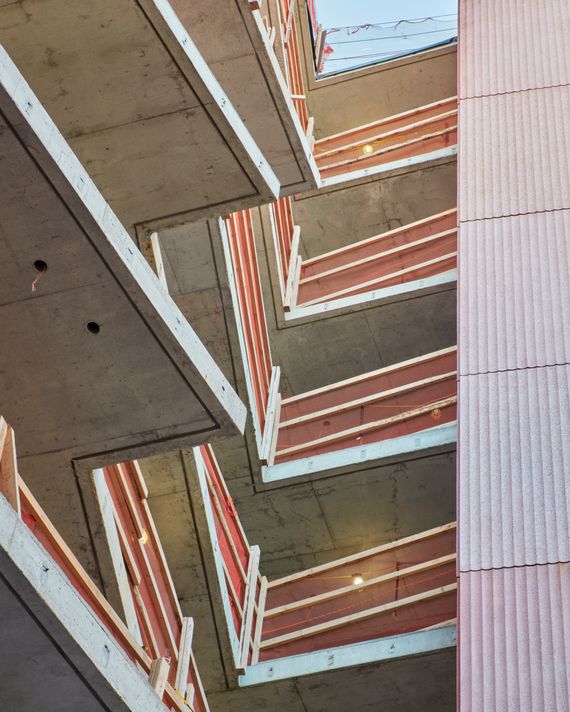
The Vanderbilt condo packs a lot of historical echoes into a small package. Clustered volumes and Mediterranean color, so striking in our gray-and-brown city, recall the view of Siena in Ambrogio Lorenzetti’s 14th-century fresco Effects of Good Government on the City. The allusion to civic order may be unintentional, but it’s apropos, since the design of 144 Vanderbilt shows how to manage New York’s cornucopia of regulations without sacrificing creativity. In 2007, the artist Julian Schnabel took pinkness and Italianate (well, Venetian) style to fanciful extremes when he built his lollipop-colored Palazzo Chupi in the West Village. But the more relevant touchpoint may be the Catalan architect Ricardo Bofill’s La Muralla Roja, a sunset-hued casbah on acid. That work in Calpe, Spain, from the early 1970s, is an assemblage of volumes linked by patios, terraces, and stairs as if the whole thing had been cultured and grown rather than planned and built. In that sense it resembles a steep hillside village like L’Estaque, outside Marseille, which in the late 19th and early 20th centuries attracted painters to its earth-toned geometries. The buildup of chiseled facets at Vanderbilt Avenue also brings to mind Georges Braque’s Cubist landscape Houses at l’Estaque.
I don’t know whether this hodgepodge of references was conscious, but it’s surely not coincidental. SO-IL has been working for years to deconstruct a building’s mass to make it seem less like a monolith and more like a town. If that still qualifies as a radical move, it’s because the typical New York apartment building is a closed box crisscrossed by hollow passages. Even architecturally ambitious towers, like those by Zaha Hadid, Frank Gehry, and David Adjaye, work essentially the same way before the surfaces go on, reserving innovation for the final fit-out. Residents zoom up a vertical shaft in an elevator and proceed along a hallway to their front door, their movements defined by a pair of perpendicular axes meant to cover the distance efficiently and uneventfully. Those are not places, not really. A mirror or a wall decoration might hint vaguely at character, but for the most part it’s understood that lingering more than a few seconds would instantly disrupt the system. Many buildings have rules to that effect: no yelling, sitting, or playing in the hallway; no parking strollers or leaving umbrellas or placing benches. The trio of Tankhouse/SO-IL projects in Brooklyn disassembles that basic arrangement, cracking open the shell of and letting the outdoors onto the premises.
In architecture-speak, porosity refers to designing with holes — giving transitional zones like windows, doors, courtyards, stairs, and other passageways their own distinctive importance. SO-IL brings the weather in, paring back walls wherever possible, turning hallways into breezeways and vestibules into semi-private porches. Instead of treating outdoor spaces as private premium add-ons, the architects have made them an organizing principle.
Whether that’s a good thing depends on the time of year and some unpredictable wind patterns: A landing that feels sheltered and pleasant on one stormy day might be suddenly gusty the next. Environmentally, that cuts both ways. The current gold standard for energy conservation is an exterior swaddled in extra-thick insulation and sturdy seams, like an expensive parka. SO-IL takes the opposite tack, making a virtue of leakiness and at the same time minimizing areas that need to be heated and cooled. That would hardly be innovative in California, or much of Europe, but it’s not the Northeast way.
The architects, led by the husband-and-wife team of Florian Idenburg and Jing Liu (the firm’s unfortunate abbreviation derives from its cumbersome full name: Solid Objectives–Idenburg Liu) have imported a format they developed for a social-housing complex in León, Mexico, where the climate is forgiving and AC optional. Las Americas, which opened in 2021, borrows its basic shape from Bjarke Ingels’s 8 House in Copenhagen, from a decade before, a long ribbon of apartments that twists into a figure eight, forming a pair of adjacent courtyards. The basic unit of SO-IL’s elegantly pragmatic design is a customized concrete block roughly the size of a man’s thigh, hollow (so that a worker can lift it unaided), white (to shield interiors from heat), stackable like a Lego brick, and shaped so that a whole wall of them comes out attractively ridged, casting narrow strips of shadow in the strong Mexican light. Out of these few elements, the architects composed a handsome, livable, six-story walk-up building where social life spills out onto open-air staircases and walkways ringing landscaped courtyards.
It’s not easy to adapt that low-budget model to a city with genuine winters and an absurdly inflexible real-estate market. Here, bending the exterior walls means indulging in extra stretches of pricey façade. Elevators push up costs. The New York imperative to build out every allowable square foot too often yields generic design; more flexible architecture risks violating real estate’s first commandment: Thou shalt not yield a single square foot. Tankhouse’s first project, 450 Warren Street, which opened in 2022, violated just enough conventional wisdom to scare off the usual lenders, so the company’s co-founder, the Buenos Aires–born ex-architect Sebastian Méndez, financed it by hitting up friends and family in Argentina. Instead of building affordable housing, as at Las Americas, Méndez and his partner Sam Alison-Mayne opted for a boutique set of condos with an ingenious mixture of roughness, coziness, and eccentricity.
Three distinct structures, connected by serpentine outdoor walkways, ring an interior courtyard. The façade steps out to the street and back again in a dance whose beats are marked by balconies. SO-IL once again began with concrete blocks — pale gray this time, mottled with aggregate and angled to lend the surface its texture and slight shimmer. Inside the perimeter, apartment front doors open onto outdoor alcoves, curving walkways, and stairs that are mostly but not completely sheltered from the rain. All those naked platforms are edged not with the usual glass railings but with stretchable steel mesh — high-end chicken wire, basically, bolted into raw concrete. That one detail creates a lightly correctional atmosphere, as if to prevent the residents of this upscale concrete jungle from indulging in condo parkour. This aesthetic won’t appeal to everyone, but SO-IL has rendered us all a service by pointing out that New York conventions are not unbreakable mandates.
With that experiment under their belts, Méndez and Alison-Mayne hired SO-IL to design three more projects: a narrow 14-story tower at 9 Chapel Street, on the edge of Downtown Brooklyn; 144 Vanderbilt; and an affordable housing complex in Gowanus that’s still being drawn up. Nine Chapel has SO-IL’s signature whitish-concrete shell, again made of those interlocking blocks but wavy rather than serrated this time, and complemented by rippling sheets of perforated anodized aluminum. The effect is corrugated, a combination of stiffness and animation that gives the building an air of vivid antiquity, like one of the medieval towers in Lorenzetti’s Siena — the kind where a party of Ghibellines might retreat after a street brawl with Guelphs. (Appropriately enough, a Catholic church, the Cathedral Basilica of St. James, stands next door to the Brooklyn site, protecting it from future construction and giving residents an up-close view of its domed bell tower.) If 450 Warren makes nice with the neighbors and turns inward for innovation, 9 Chapel stands up and demands to be noticed, especially as a contrast to the big bland slabs all around.
With its loose bundle of square pipes and boxes piled slightly out of alignment, the building nods at the New Museum, which Idenburg helped design when he ran the New York office of the Tokyo firm Sanaa. The two buildings share an irreverent attitude, a fondness for meshlike materials over a solid underlayer, and the deft arrangement of tight spaces. But SO-IL isn’t the kind of firm that finds a gimmick and keeps cranking out sequels. Rather, it distills lessons from one site for the next, shuffling elements and introducing new ones. If you loved the last one, you may or may not like the next.
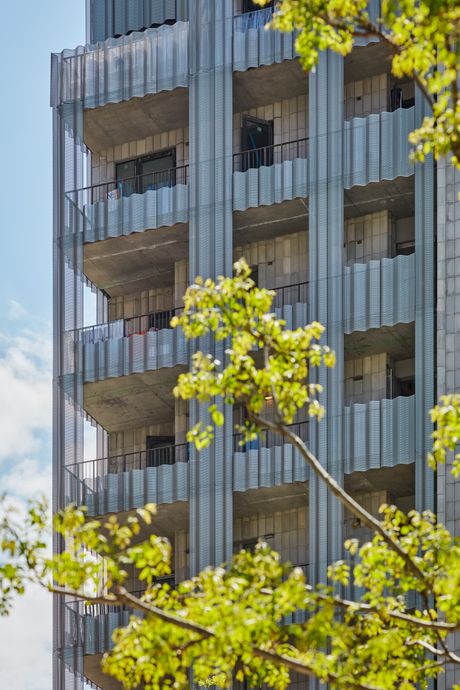
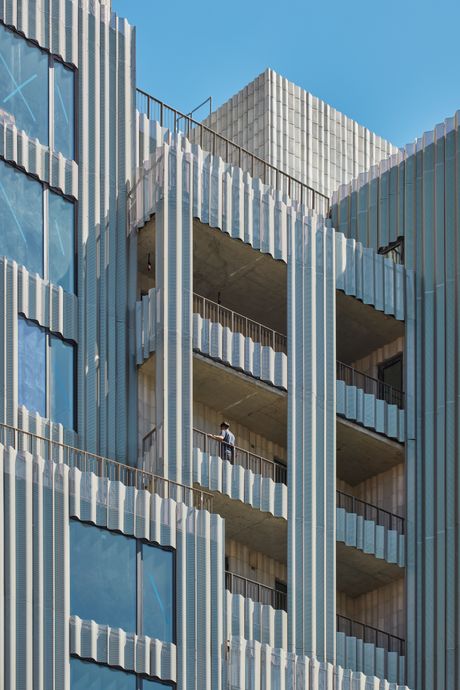
New York prides itself on idiosyncrasy, but the architectural version is really a precious luxury in a city where zoning rules keep wildness in check and brokers dictate design with a set of elaborately detailed beliefs about what does and doesn’t sell. It often seems like you could feed those principles into an algorithm and have an AI bot spit out drawings, bypassing architects completely. Tankhouse takes the risks that small-scale architecture allows. When I asked whether an open passageway through the heart of the building might not turn into a wind tunnel on a particularly gusty winter day, Alison-Mayne acknowledged that he couldn’t be sure. Wind, like taste, is only somewhat predictable.
The partnership between developer and architect allows both to keep pushing each other in productive crescendo. Tankhouse buys only corner lots, and SO-IL makes the most of the three (or four) visible sides, conceiving architecture not as rooms clothed in replaceable façades but as urban sculptures that fold in on themselves, interlacing surface and volume. At 9 Chapel and 144 Vanderbilt, Tankhouse and SO-IL eked out a little more space and charm by digging down, rather than building up. A hidden garden and a suite of amenities lurk below sidewalk level, sheltered by the building’s underbelly and punctuated by a set of fat columns. What might have been an open-air basement or a troll’s lair under an overpass instead has the airy yet sheltered feel of a Brooklyn backyard.
These three SO-IL opuses matter not because of the expensive experience they provide the few who can afford to buy there but because they demonstrate that architecture can happen, even in formula-prone New York. The modest tower at 9 Chapel packs more flavor and personality into 14 stories than the whole forest of newish skyscrapers in downtown Brooklyn can muster. I’m not suggesting that others should copy 144 Vanderbilt — not even its architects should do that — but that if more of Idenburg and Liu’s colleagues thought small and bold rather than big and safe, we’d get fewer bland behemoths. It’s common practice to disguise ruthlessly basic structures with fancy finishes; Idenburg and Liu have taken the opposite approach, leaving surfaces plain so as not to compete with creative form. It’s promising that the team is now working on a larger affordable housing project, adapting their experience to the strictures of a super-tight budget and stringent city rules. Maybe SO-IL will eventually come full circle and produce Las Americas North.

